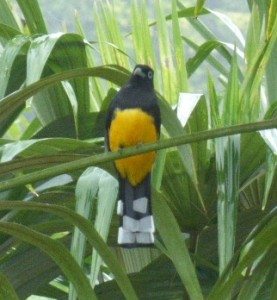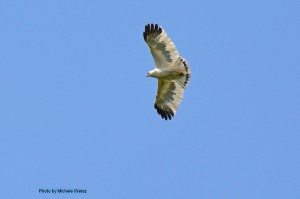Birding Belize with GGBA
By Carol and Steve Lombardi
In early February, 2014 we “traveled with Golden Gate Bird Alliance” on Mark Pretti’s Belize tour.
Belize is small and sparsely populated. Much of its original habitat is intact, so it’s a great place for a nature tour—and Mark is a wonderful guide. Not only did we see over 200 bird species, we also learned a lot about tropical ecology and the other flora and fauna.
Upon landing and surviving the immigration lines, we exited Belize’s teensy airport and met Mark on the sunny sidewalk. After introductions—a quick process with only 10 in the group—we boarded our bus for the short ride to the Radisson. Our original plan was to immediately leave Belize City for Crooked Tree Lodge in the hinterlands. However, heavy rains had closed the road, so we were forced to endure one night in a luxury hotel on the seafront. Birding nearby consoled us with some species we wouldn’t see in the countryside: Scissor-tailed Flycatchers, Cinnamon Hummingbird, Magnificent Frigatebirds, Bronzed Cowbirds, Great Kiskadee, Sandwich Terns, a Merlin, and the first of many Golden-Fronted Woodpeckers.

Next morning began our trip in earnest with a stop at the Belize Zoo, which offers a small but vivid collection of local fauna—Harpy Eagles, macaws, jaguars, spider and howler monkeys, and adorable tapirs—plus many free-flying birds visiting the water and food containers, including Ruddy Ground Dove, Northern Waterthrush, Chachalaca, Yellow-olive Flycatcher, Yellow-fronted Euphoria, Common Tody Flycatcher, Hooded Warbler, Hepatic and Summer Tanagers, and Yellow-billed Elaenia. Six-foot-long iguanas basked on the ground and in trees.
Our next stop was Guadalcaste National Park, which offers several trails through lowland forest habitat. An Amazon Kingfisher perched along the Belize River and a Howler Monkey family lounged overhead, but the best sightings were from the parking lot: A female White-bellied Emerald carried spiderweb strands to an undisclosed location, a Yellow-billed Tyrannulet patrolled the shady edges, and Olive-throated Parakeets fed on blossoms in the treetops.
After a delicious Caribbean lunch — where we learned the difference between “beans and rice” and “rice and beans” — our bus climbed through damp foothills to Pook’s Hill Preserve for four nights. The cluster of cottages is surrounded by a variety of habitats (including a Mayan ruin), and we explored them all: The forest trails, the open meadow, the creekside tangle. Even a brief stroll across the driveway might yield Slaty-Tailed or Black-headed Trogon, White Hawk, White-collared Seedeater, or Long-billed Hermit—not to mention the local family of Howler Monkeys, an assortment of lizards, and the ever-present leafcutter ants.


A word about our accommodations. Every place we stayed was clean, comfortable, and well maintained. However, a couple of spots were somewhat rustic, with thatched roofs and window screens only (no glass). We wound up sharing our rooms with several local critters, with no ill effects to us or them. Every room had its own house gecko, cheerfully chirping somewhere in a corner. We also had anatole and basilisk lizards and a variety of harmless insects and spiders. All the staff people were wonderful, and the food was uniformly good.


Pook’s Hill expanded our bird lists by dozens of new and local species: Jacamar, Spot-breasted Wren, Cacique, Lineated Woodpecker, Ant Tanager. Pale-billed Woodpecker, Green Honeycreeper, Aracari, Keel-billed Toucan, White-collared Manakin, Black-headed and Buff-throated Saltators, Ochre-bellied flycatcher, White-fronted Parrot, Smoky Woodpecker.
A Broad-winged Hawk devoured his reptilian breakfast as we watched. Multiple parrot overflights occurred daily. At night, we could hear the Pauraques calling, the chuck-chuck-chuck of a Spectacled Owl—and the Howlers. Their deafening concerts might last 5 minutes or stretch to 45 and often started at 2:00 AM. Birders, pack your earplugs!
We said farewell to Pook’s Hill and hit the road. Belize is not a wealthy country, and all of our destinations took us along miles of pot-holed dirt roads. Our excellent drivers did their best to provide a comfortable journey, but circumstances (and the recent rains) made it difficult. Our bus rides were like Tigger: bouncy.
At Green Hills Butterfly Ranch we entered a room filled with gorgeous fluttering creatures: butterflies carefully raised and nurtured onsite.


A feeder in the yard gave us great looks at Violet Sabrewing and several other hummingbird species before we proceeded to Hidden Valley Lodge—an elegant mountaintop retreat with lovely gardens and a genius in the kitchen.

After lunch, we visited King Vulture Falls to marvel at the falls, the King Vultures, and a rare Orange-breasted Falcon that was perched across the valley. The drive to Thousand-foot Falls produced good looks at a Rusty Sparrow and Rufous-capped Warbler. Next day, we found that the road to the famous Caracol Mayan ruins was closed because of rain, so we opted for an easy downhill hike to Rio Frio Cave. We jockeyed around to get looks at Tawny-winged Woodcreeper and Northern Barred-Woodcreeper in the quiet forest. Suddenly, a mixed feeding flock flooded across the road—and we didn’t know where to look next. Yellow-bellied Elaenia, Sepia-capped Flycatcher, Eye-ringed Flatbill! Black-throated Shrike-Tanager, Blue-black Grosbeak, Blue-winged Warbler! Golden-winged Warbler, Baltimore Oriole! Breathless!
Strolls through the Hidden Valley Lodge’s grounds brought us Yellow-faced Grassquit, Hepatic Tanager, Yellow-tailed and Yellow-backed Orioles, Gray-crowned Yellowthroat, Black-headed Siskin, and Azure-crowned Hummingbird. On the way to breakfast, we spied a Ferruginous Pygmy Owl perched in the garden.
Any birding tour to Belize will acknowledge the warm, humid climate and abundant insect life. Inspired by Mark’s infamous botfly stories, we all took our individual precautions against mosquitos, blackflies, and chiggers. Citronella spray, Skin-So-Soft, a daily dose of DEET, and that geeky pants-tucked-into-permethrin-treated-socks look were all deployed with varying success. Choose your weapons and pack quick-dry socks.
After two nights, we were back on the bus. The long ride down to the coastal plain was followed by a swift boat ride 26 miles up the New River to Lamanai Lodge. The boat slowed to preview the rich riverside habitat: An Osprey flew overhead carrying his lunch, Limpkins stepped through reeds along the bank, and Tropical Kingbirds fluttered to flycatch here and there. After dinner, a night boat ride found Ringed Kingfisher, Boat-billed Herons, Pauraque, and Lesser Nighthawk. The rain started just as we returned to our rooms.

A walk through the nearby forest brought us to massive Mayan temples—adjacent to looming hills containing still-unexcavated structures. We spotted White-necked Puffbird, Blue Bunting, and a pair of Lineated Woodpeckers. Among the ruins of the Jaguar Temple we heard and saw Howlers, then —a surprise to all — a small group of Spider Monkeys!
We boated to the opposite side of river, which hosts completely different soil and therefore a different plant assortment: Not jungle, but savannah, right out of an African travelogue. Botteri’s Sparrow and more TKs (now reduced to shorthand familiarity) perched for good views. Back on the river, we watched a Snail Kite dive to collect a meal and visited a Laughing Falcon at its roost. Anhingas flew by, often accompanied by Neotropic Cormorants—a good study of their different wingbeats. A short hike near the lodge produced Wood Stork, Little Blue Heron, White Ibis, Barred Antshrike, and Blue-black Grassquit. We had to step lively to avoid a river of army ants foraging in the road. A leisurely afternoon boat ride on the forested side added Short-tailed Hawk, Green Kingfishers, and Sungrebe to our lists, not to mention proboscis bats roosting head-down on tree trunks.


On the morning of our departure, a Bat Falcon decided to perch on the lodge’s radio mast.
As we boated back down the river on our way to the airport, a Morelet’s Crocodile cruised our way, leading with a very, very toothy grin. It dived under our boat. We broke into applause.
Two wonderful photo collections from this trip are available online. Thanks to Michele and Larry for sharing these links with us:
Michele Weisz’s flickr gallery
Larry Kuo’s picasa gallery
———————————————–
Inspired to try some birding travel? Check out other Golden Gate Bird Alliance travel opportunities, including trips with Mark Pretti to Colombia in June 2014 and Brazil in August 2014. We also have openings on upcoming trips to New Mexico, Ohio, Eastern Oregon and Alaska. When you book a birding trip through Golden Gate Bird Alliance, you are assured of the highest quality naturalist guides. And a portion of your fee supports GGBA as a tax-deductible contribution.
Prefer to explore new birding areas closer to home? Together with Rich Cimino, Steve and Carol Lombardi will be co-leading a Birdathon trip on Sunday April 13 to Mines Road and Del Valle Park in the East Bay. Info on our Birdathon Field Trips page.
